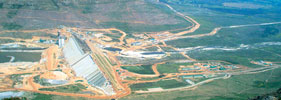
The Berg Water Project is the culmination of a 14-year process by the Department of Water Affairs and Forestry to identify appropriate measures to address the pending water shortage in the Western Cape. The project’s goal is to increase the yield of the Western Cape Water System by 18% per year.

The Berg Water Project (BWP) is designed to capture the winter rainfall and store it for supply to the City of Cape Town during the dry summer months. BWP is the first bulk water resource development project that is directly linked to water demand management.
SSE Cape has been appointed by main contractor Sulzer to implement the scada, telemetry and wireless communications for this prestigious project.
System overview
The telemetry system will enable remote control of the two isolated pump stations, monitoring of the water flowing into the new dam and surrounding rivers as well as the water being pumped into the tunnel at Dasbos.
The remote pump status, levels and flow data will be relayed to the control room at Dasbos pump station as well as the Department of Water Affairs (DWA) control room in Worcester.
System description
The various operations of the completed Berg Water Project will be controlled and monitored by a Citect Version 6.1 - supervisory control and data acquisition (scada) software package and the SSE Maestro telemetry remote terminal units (RTUs).
The RTU situated at each master station will interface to the Citect SCADA via SSE's Picasso OPC. This configuration allows powerful remote programming of the Maestro RTUs in the field.
The Citect SCADA is situated at the main control room situated at the Dasbos Pump Station and will interface with local PLCs and remote RTUs via high speed MDS digital radios and a series of Airaya 5,4 Gig wireless Ethernet links.
For more information contact Clive Maasch, SSE Cape, +27 (0)83 658 3231, [email protected], www.sse.co.za
What is OPC?
OPC is a series of standards specifications. The first standard (originally called simply the OPC Specification and now called the Data Access Specification) resulted from the collaboration of a number of leading worldwide automation suppliers working in cooperation with Microsoft. Originally based on Microsoft’s OLE COM (component object model) and DCOM (distributed component object model) technologies, the specification defined a standard set of objects, interfaces and methods for use in process control and manufacturing automation applications to facilitate interoperability. The COM/DCOM technologies provided the framework for software products to be developed. There are now hundreds of OPC Data Access servers and clients.
Adding the OPC specification to Microsoft’s OLE technology in Windows allowed standardisation. Industrial devices manufacturers could write the OPC DA Servers and the software (like HMIs) could become OPC Clients.
For the users, the benefit of this was flexibility. They could now choose software suppliers based on features instead of 'Do they have the driver to my unique device?' They do not have to create a custom interface that they must bear the full cost of creating and upgrading through operating system or device vendor changes. Users were also assured of better quality connectivity as the OPC DA Specification codified the connection mechanism and compliance testing. OPC interface products are built once and re-used many times; hence, they undergo continuous quality control and improvement. The user’s project cycle is shorter using standardised software components. And their cost is lower. These benefits are real and tangible. Because the OPC standards are based in turn upon computer industry standards, technical reliability is assured.
Source: www.opcfoundation.org

© Technews Publishing (Pty) Ltd | All Rights Reserved